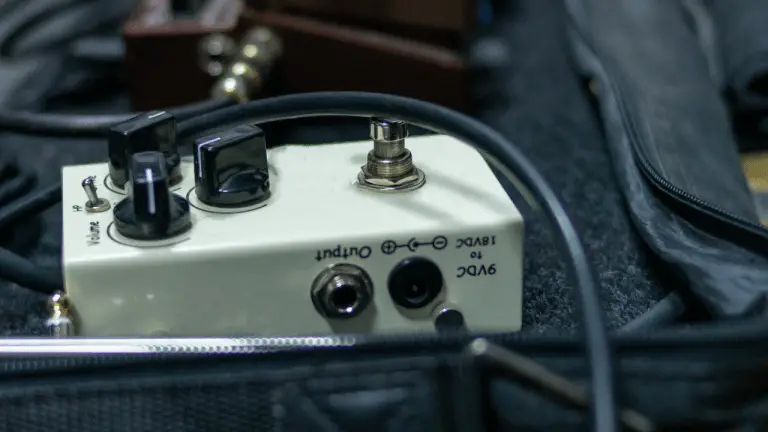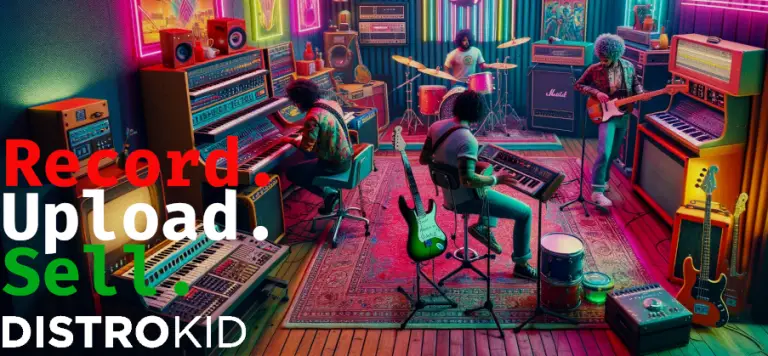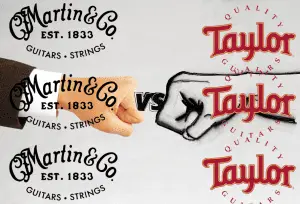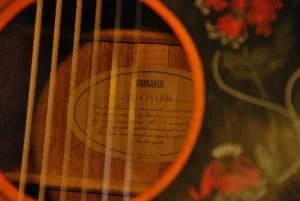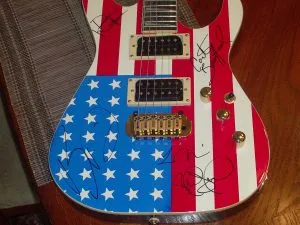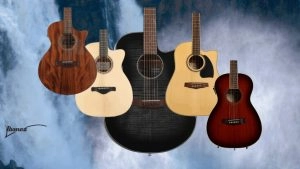If you’re in a hurry, I settled on the TC Electronic Flashback 2 as my preferred choice among the best delay pedals in the market. It’s a digital powerhouse that has expansion capabilities and is easy on the wallet. Pick one of these up to start your journey into the world of delay.
How much thought have you given to the delay stomp box in your arsenal? Does your pedal board even have a delay capability yet?
It’s perfectly okay if it doesn’t. Mine didn’t for years. Blame the punk scene.
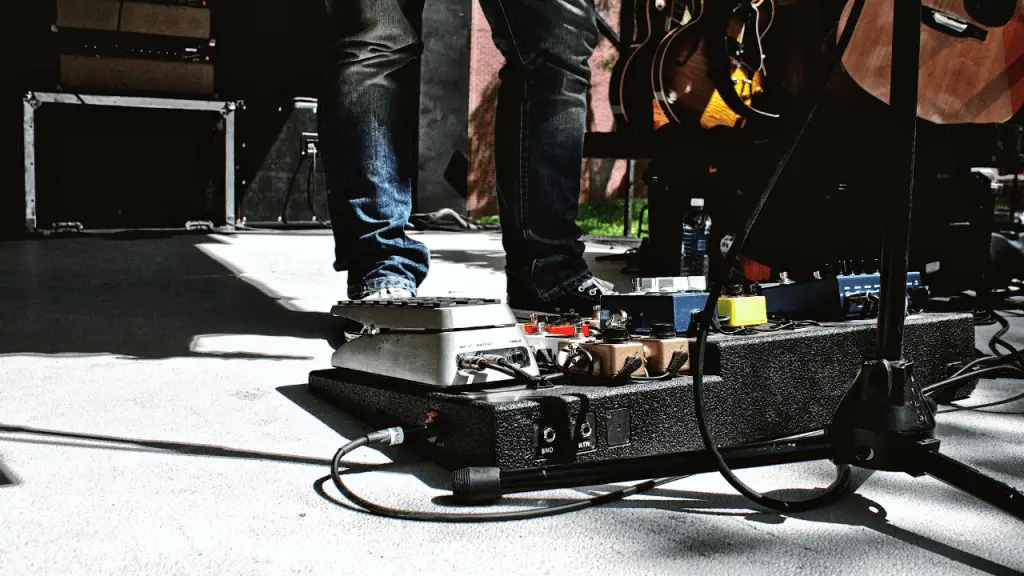
Pedalboard configuration is a serious task for guitarists of every level. While it may seem a bit technical to the uninitiated, it’s the best way to ensure you have all of your equipment at your fingertips in one place.
In this article, I will highlight the best delay pedals for different players in a number of scenarios, while offering you my personal perspective on why these choices are the best.
I’ve been playing for more than 15 years and over that time period, I’ve owned several delay pedals. I’ve had the good fortune to record with several more. I’ve come to find that, while the best delay pedal is somewhat subjective, the best delay pedals share some characteristics.
Here’s a quick list of the best delay pedals I’m going to review in this article (more detailed reviews below):
The Best Delay Pedals for Every Situation
Let’s now have a more detailed look at each pedal.
1. Boss DD-3T — The Best for the Familiar
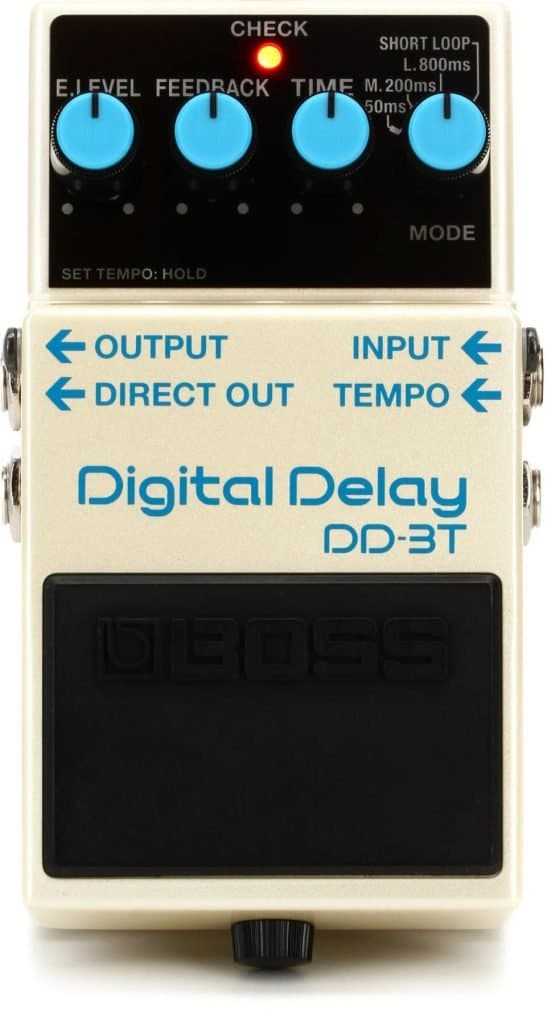
The DD-3 is the most in-demand digital delay pedal on the market. There is a reason why this pedal has been on countless pedalboards since its original release, and today’s musicians expect this pedal to remain on the board.
With its 800 ms of delay time and clear accurate delay tone, with reverse and modulation features built in, you have all the tools at your disposal to work with one of the most legendary high-end digital delays delays ever designed.
It features studio-quality sounds and is updated with convenient features like tap tempo, modulation, and delay time adjustment. If classic delay sounds are what you’re after, this pedal has what you need.
In practice, this is a very approachable delay pedal. Whether you’re recreating the sound of a world-famous guitar player like Thom Yorke or just trying to cut your own sound in a garage band, you won’t be disappointed with the Boss DD-3.
I’ve owned several of these pedals throughout the years. They are a mainstay, and it seems like everyone you run into will either have or have had used this delay at some point. They are a great entry point for dipping your fingers into the delay pedal world.
When you’re ready to move on, there’s a strong demand on used gear sites for this legendary pedal.
• • •
2. Strymon El Capistan dTape Echo — Best for Tape Nerds

At the heart of El Capistan dTape Echo is a fully analog signal path based on Strymon’s time-tested algorithms.
Like its progenitors, it features variable bandwidth and tone filtering, tape speed manipulation, dTape mode with saturation, flat mode for high-headroom clean delay, and xMode for special custom mode FX possibilities.
All of this is packed into a powerful pedal that gives you four control knobs and two footswitches (one bypass toggle and one tap tempo) to control all the features. At max delay time, with feedback at maximum, you can expect over 600mS of pure analog delay pedal goodness.
With everything packed into this little box you can mix and match the sounds of three tape technologies to create your own custom sound. The addition of a spring reverb is a nice sonic touch.
Most software emulation aims to replicate the sound tones of a specific amp or perhaps analog delay pedals you’d recognize. An emulator might try and emulate a marshall JCM 800 amp for instance.
Strymon takes a slightly different tack. In that same example, strymon is emulating the tubes, switches and wiring that make a JCM 800 sound the way it does. With the dTape Echo, they’ve even emulated the age of the analog tape.
I really like that Strymon is emulating the underlying technology that created some famous tape machines today’s players seek out. It’s like diving into the DNA of what makes something great.
I’ve only had the privilege of playing with this pedal in the context of studio recording, but I can say that I instantly fell in love with it. It’s not a pedal I’d necessarily need when playing live. It’s an analog delay that needs to be appreciated, over a long period of isolated time.
For that reason, it’s a great pedal, but perhaps not the best delay pedal for a player who doesn’t already have a workhorse delay in their kit.
• • •
3. MXR Carbon Copy — Best for All-Around Analog Delay

With Carbon Copy, MXR has crafted what may be the most organic, true-blue analog mode delay effect pedal ever constructed. The Carbon Copy’s controls are simple enough for even the most novice player, and its delay time is adjustable from five milliseconds to a generous 600ms.
But above all, the beautiful, warm tone that this pedal produces is like no other — an utterly addictive analogue ambience that will yield pleasurable results whether used with electric guitar or keyboards. It’s instantly recognizable.
The MXR Carbon Copy comes in the standard size that we’ve all come to love, as well as a mini version that has the same feature set for the same price. It’s just, well, diminutive.
If you’re feeling lighter and brighter, you can get the Carbon Copy Deluxe which is essentially the Carbon Copy and the Carbon Copy Bright pedal in one housing. It costs a slight bit more, but it also doubles the amount of delay available to a full 1,200ms.
Like the Boss DD pedals, there’s a lot of demand for used MXR pedals. Because MXR makes just about every effects pedal under the sun, there are some players who spend their entire lives within the MXR ecosystem, building entire effects loops with the MXR technicolor pedal rainbow.
What I like most about the MXR Carbon Copy is that it’s more than a single pedal. It’s a pedal with a series of flavors. I still have the mini edition in storage because from time to time, it comes in handy for recording projects. And it’s my go-to for a budget pedal I wouldn’t feel sick about losing at a gig.
• • •
4. Strymon Timeline Multidimensional Pedal — Best for Versatility
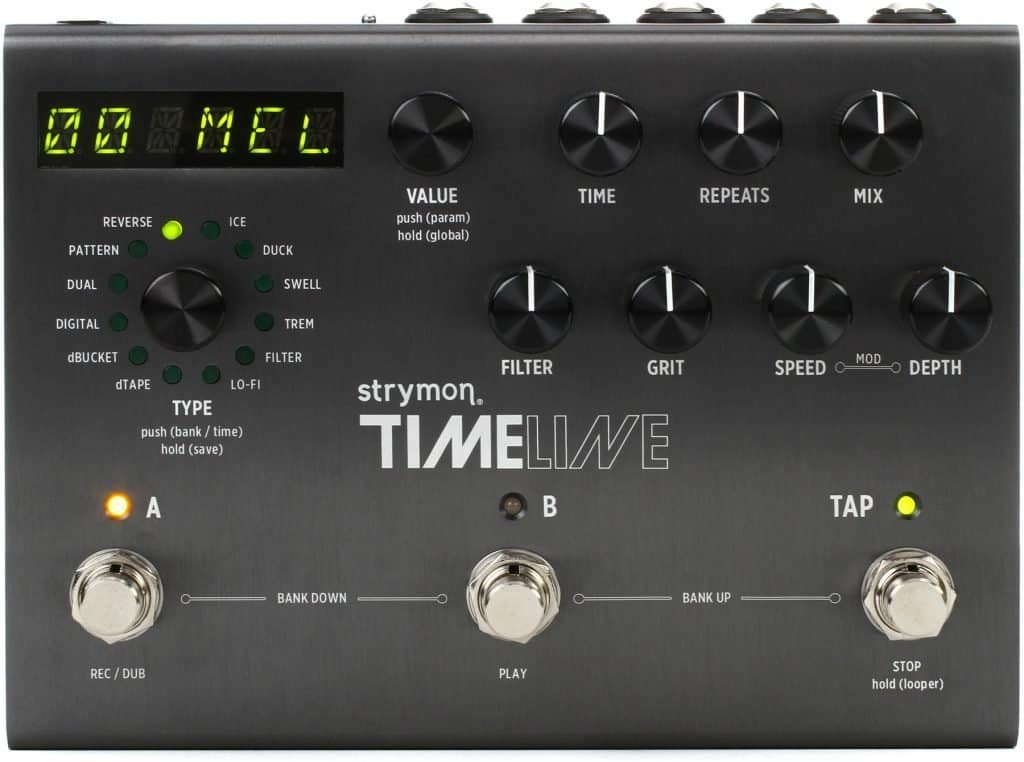
The TimeLine is Strymon’s most comprehensive delay effect unit to date and the perfect centerpiece addition to any musician’s pedal board. It isn’t cheap. In fact, it comes with the highest price tag, but it has a feature set to match.
A powerful Filter section and Freeze mode give you access to all the possibilities that a definitive delay pedal has to offer. With its wide selection of knobs, you can tweak the tone for extreme or subtle use.
Ensuring that it will stand out on your board, its effects color switch is an extremely unique feature that allows this pedal to have practically unlimited sounds. I’m not exaggerating when I say this can take your sound from the bedroom to a cathedral in one flick of a switch.
Like the other Strymon pedals on this list, the versatile feature set and price tag mean that this is a pedal best suited for the sound creation phase of the musical creative process. If you want an excellent example of why this is the best delay pedal for studio settings, then you can do no better than listening to a Minus the Bear record.
You would be hard-pressed to find a band who has done more with delay over the past decade than Minus the Bear. And Dave Knudson’s delay pedal of choice is the Strymon Timeline Multidimensional.
• • •
5. TC Electronic Flashback 2 — Best for Players on a Tight Budget
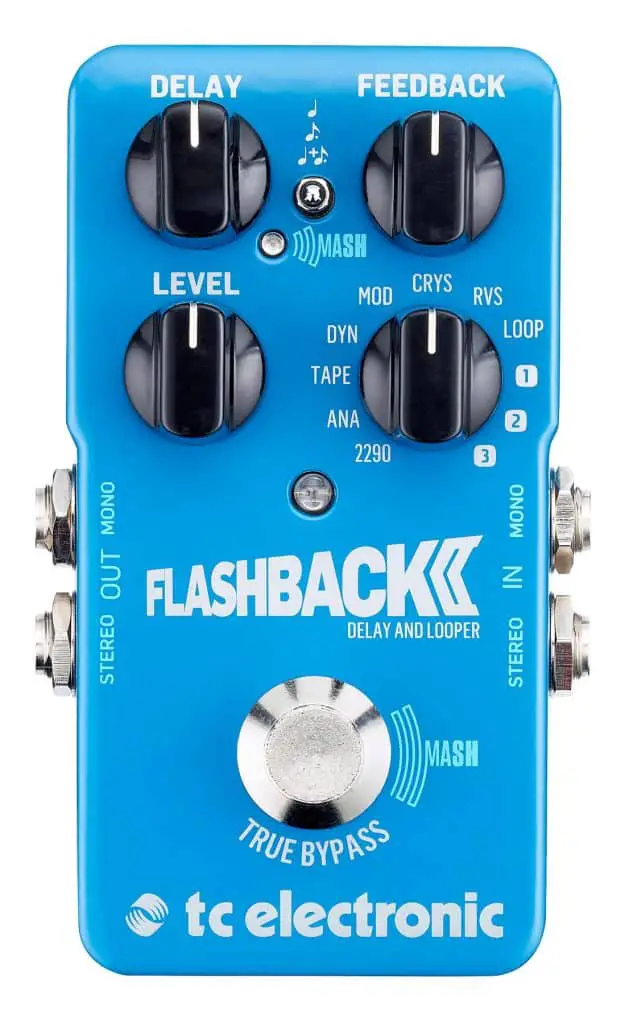
The Flashback 2 Delay’s features are all about ease of use and high sound quality. The intuitive design includes updated controls, new features such as TonePrint and preset memory, easier navigation, full compatibility with TonePrint apps, MIDI functionality, and a stomp box format that works perfectly with the pedal board concept.
This makes it an exceptionally popular live pedal.
Numerous delay modes with optional modulation, tap tempo functionality for precise delay times, analog-circuit modeled tone from past delay pedals, and a wide range of delay time settings: The TC Electronic Flashback 2 Delay/Looper pedal has everything you need to put your sound front and center.
What I really liked about this delay pedal is the “MASH” foot switch. Depending on the pressure you apply, and for how long, you can create big swelling soundscapes. Think of it like the expression pedal on a wah pedal. Whereby you can change the amount of effect the pedal is applying in real time.
It’s not something you see on most stomp boxes at all, but it works really well with the delay and modulation on the Flashback. This is the type of stomp box that extends the usefulness beyond a mere six strings.
I don’t currently use this pedal, but when I was, I found myself using it a lot for song writing ideas. The built-in 40-second looper and small size was what made it perfect for coming up with ideas during quarantine when there were toddlers and large dogs in the space. Coupled with a mini Squier Stratocaster, I was able to get a lot of music done under less than ideal circumstances.
If you have similar externalities where you want cheap gear, then you can’t go wrong with my choice for the right delay pedals for players on a tight budget.
• • •
6. Boss DM-2W – Best for Indie and Prog Rock
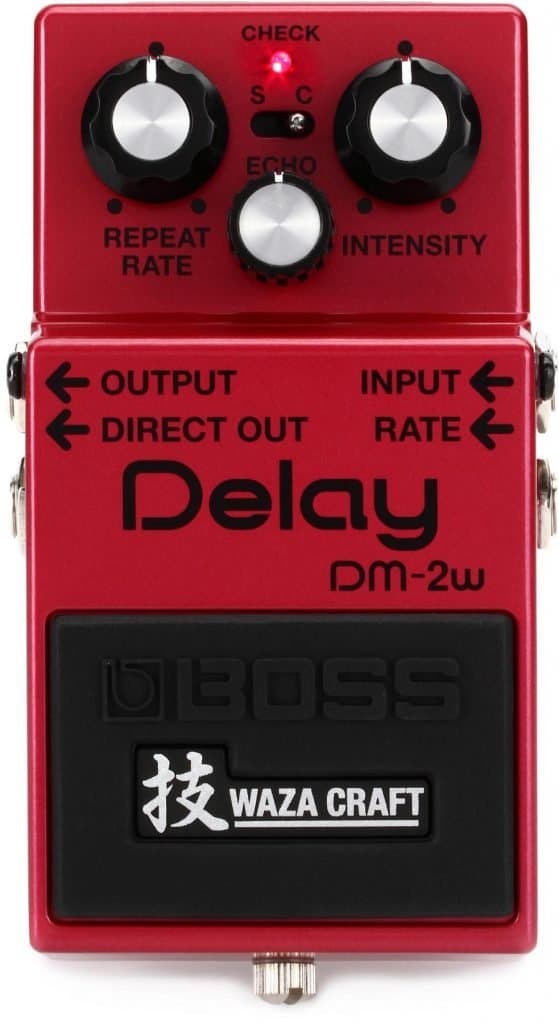
The BOSS Waza Craft DM-2W is a delightful throwback to one of the most popular and hard-to-find pedals from the 1980s.
While reproduction versions are floating around on eBay or the occasional Craigslist score, it ain’t easy. This version was developed by BOSS in conjunction with Mike Matthews and the Waza Craft shop in Tokyo, and almost immediately stood apart from the ocean of other BOSS delays available.
A Classic Is Born
This pedal is perfect for producing dark delays as heard on songs such as Pink Floyd’s “Breathe Reprise” or U2’s “Where the Streets Have No Name.”
When I was first experimenting with delay pedals a decade ago, I was obsessed with the first 90 seconds of the Joshua Tree. It changed what a single guitar player could do. Years later I got the opportunity to play an original DM-2 and wasn’t sophisticated or patient enough to get around the quirks of the pedal’s timing circuit.
BOSS eliminated all the original’s idiosyncrasies. The reissue is all about vintage tone without the vintage headaches. Now I have no qualms owning one of these pedals and have no problems taking it live.
The price point is right in line with the rest of the BOSS delay pedals, so it won’t break the bank by any means. If you have a specific indie rock, or prog rock genre you’re going for, you can get the sound you’re after without the need to spend up to the Strymon standard.
• • •
7. Strymon Volante Magnetic Echo Machine — Best for a Second Purchase

The Volante is a boutique-worthy echo/delay pedal with an all-analog signal path that clocked in at #4 on Premier Guitar’s Best of 2015. Each of its four delay playback heads can be set to one of three delay effects: Tape, Analog, and Modulated digital.
Options Without the Learning Curve
The pedal’s intuitive design and 10 instant preset slots make it easy to quickly dial in delay sounds, from very short slap back repeats all the way to infinite delay trails. It also features a built-in looper with 48 seconds of recording time, MIDI capability, and an analog dry-through for serious tonal clarity.
It is difficult to express how much you can do with this pedal. There’s a lot of overlap between the Strymon pedals on this list, but each has their own specific strengths, and the Volante is hands down the best delay pedal to complement any other delay pedal you’ll ever own.
If you have the Volante in your stable of pedals, you can buy just about any niche delay pedal you want, and between the two, have any conceivable delay you want covered. That doesn’t mean the Volante isn’t a strong stand-alone pedal in its own right. It is. It will do 80% of just about anything with ease, sophistication, and granular detail.
Strymon is known for producing top of the line pedals that are top of the line. With the Volante, they’ve created the top of the line companion delay pedal.
• • •
8. Electro-Harmonix Canyon Delay and Looper Pedal – Best for Those Who Like a Lot of Action in Small Packages
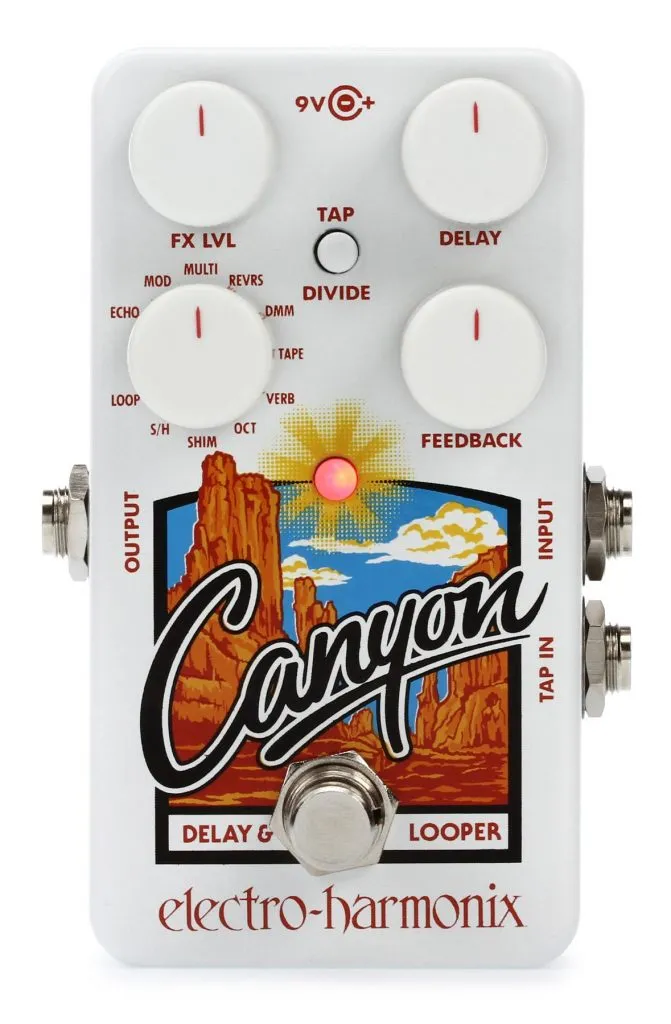
Let’s get this out of the way: the Cayon Delay and Looper is a work of art. Not only does it look unique and beautiful—even the pedal knobs look cool—but it packs so many features into such a small pedal.
The stomp box has eight modes, including the deluxe memory man, tape echo, and my favorite for writing guitar solos, a reversed signal mode. You can also use the tap tempo mode at any time your heart desires, so you can easily speed up or slow down any guitar signal sample.
It has to be in any conversation about the best digital delay pedals. But it’s not only the digital delay that is fantastic — it’s also the fact that somehow they found room to include a reverb that is reminiscent of some of the classics.
Blend those reverb controls into your digital delay, and you’re automatically creating art.
I can understand why it has been described by some fans as a digital delay “swiss army knife” or a desert island delay sound.
Sure, it isn’t perfect. Nothing is. It would be doubtful you’ll be using all the delay sounds as some have been described as gimmicks. But considering they’ve packed 62 seconds of delay time into a tiny guitar delay pedal, I think Electro Harmonix gets a pass on the occasional gimmick.
• • •
9. Boss DD-500 Digital Delay Pedal – Best for Boss DD Heads
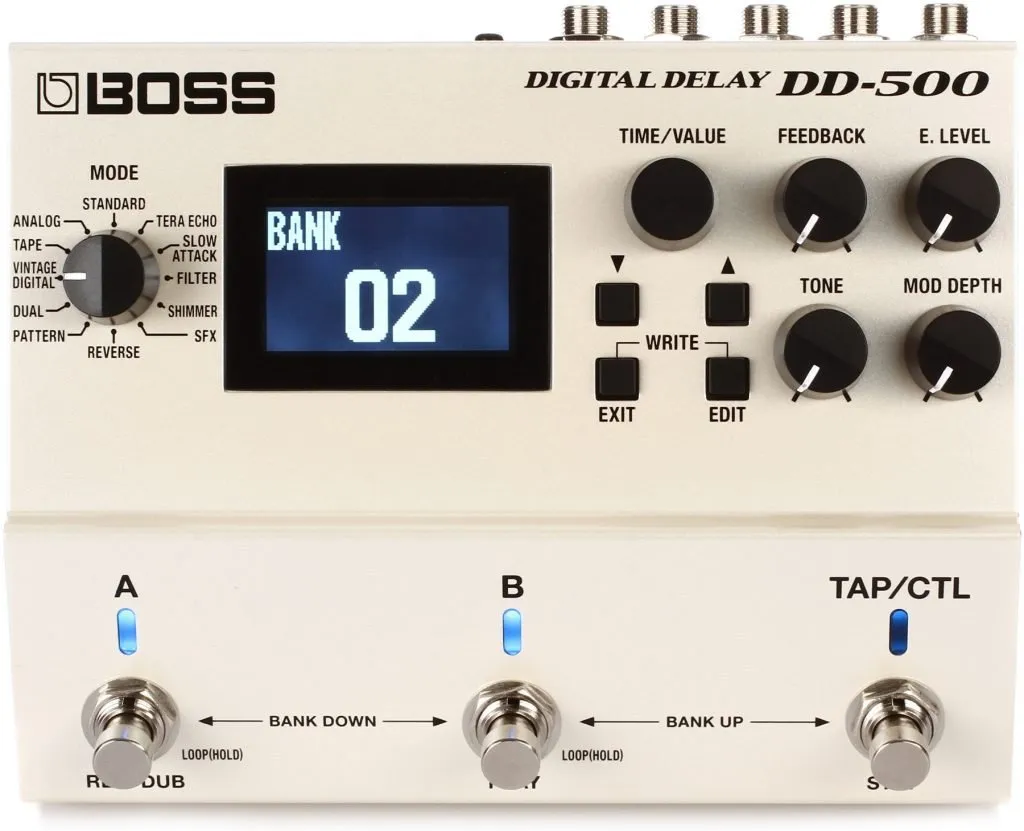
You’ve met them. Players who won’t touch anything that isn’t a Boss pedal. They might have a touch of OCD, but hey, I myself am a sucker for a classic pedal from Boss, and they’ve really outdone themselves with the Boss DD-500. I might be a convert.
The Best Boss Has to Offer
The modulation controls and delay control on this beast are nearly unlimited. It features three onboard toggle switches that can be assigned to any function. They are, by default, used for changing presets and the tap tempo. On the back, there are midi ports, a USB port, your standard unbalanced outs, and the ability to use an external footswitch or two to add even more live control.
The 12 delay types cover your classic digital delay, as well as analog delays, tape echo, and delay tones designed to emulate other boss digital pedals, as well as analog. In addition to the traditional delays, there are modern digital delays as well that combine effects to create preset tones that are unique to the Boss DD-500.
Beyond the presets, this digital pedal can really do anything you want. You will find yourself going down the rabbit hole and getting lost in its delay effects. The delay times are up to a solid 10 seconds, and the looper on this thing allows layers upon layers to create intricate performances.
If you’re looking for a powerful digital delay solution that has external pedal control options and unrivaled delay settings, then take a serious look at the Boss DD-500. Assuming you’ve got the coin. Oh, and save a little extra for the unincluded power supply.
• • •
10. Source Audio Nemesis Delay – Best for Those Who Need Every Effect and Don’t Have Other Time Commitments

The Nemesis is a digital delay that does a tremendous job emulating all of your basic analog delay, tape delay, and other standard delay modes while bringing a ton of additional functionality to this small package.
Right out of the box, there are 24 presets built in that emulate some of the best analog delay pedals available, as well as a delay sound or two you may not have heard from the rockabilly days.
Choice After Choice After Choice
In addition to the modes, there are six control knobs that allow the player to tweak the slightest detail until their ears are content. It has two inputs, so you can run distortion pedals or other effects into a single delay channel. The two outputs can run as mono or stereo out. Once you’ve settled on the delay tones you like, you can save those as presets in up to 128 slots using the midi function.
It also has an input for an expression pedal and a proprietary input for other Source Audio products. If you get lost in the options and need a true bypass to start over, the Nemesis has that as well.
The tap tempo mode can be broken down by quarter notes, 8th notes, and triplets with the flip of a switch which can add quite a bit to a performance.
I had a particularly fun time with the reverse delay, tape delays, and the other analog delay pedals that the Nemesis emulates. It really seems possible to create just about any sound you can think of, but the learning curve will be a bit steep. As will the price, but that’s a lot of functionality in a small package.
• • •
11. Dunlop EP-103 Echoplex Delay Pedal – The Analog Delay Pedal for Those in the 60s
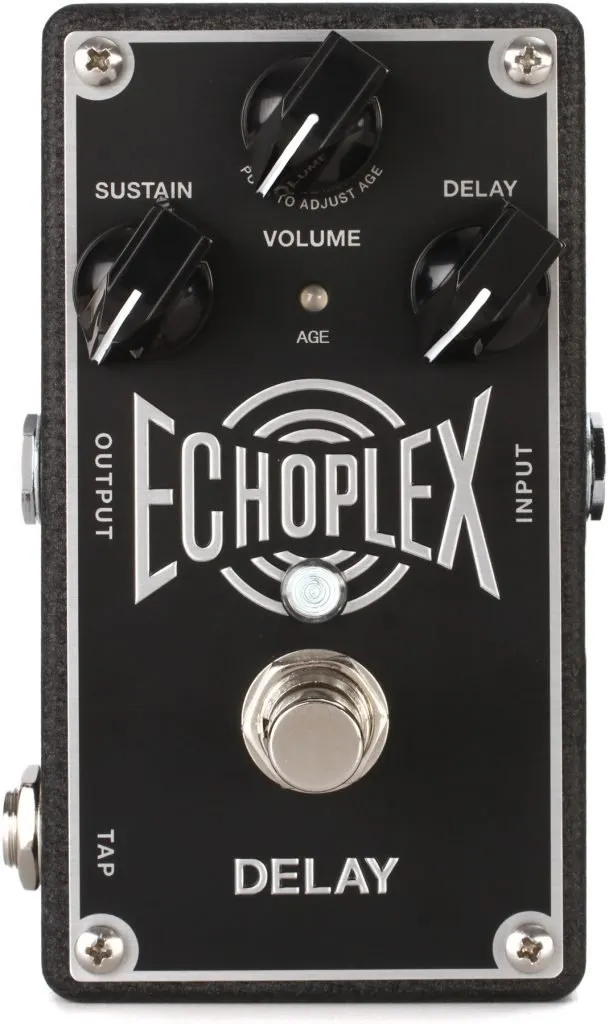
There’s no denying that this delay pedal by Dunlop is a straightforward child of the 1960s sounds in rock. Nothing wrong with building something to honor the past, and if the 1960s sound is your jam, then take a look here.
Eschewing fancy multimode offerings of its digital delay counterparts, the EP-103 features a fully analog dry signal path and is built to nail the classic tape delay sound of the era. You don’t even get a built-in tap tempo feature. The tap tempo feature comes from an add-on pedal built specifically for the purpose. That’s rock and roll.
A Dedicated Rocker
And nail that sound it does. Analog tape has a life to it, and one of the coolest features of this pedal is the “age” function. In this analog delay mode, you’re able to simulate a tape delay that is using an increasingly older piece of tape.
As we talked about a photocopy of a photocopy, each generation of delay degrades faster, grittier, and darker. Having the chance to really soak in that analog delay feels authentic. I wasn’t around in the 60s, but I imagine this is what a specially built analog delay is supposed to sound like. It’s not an afterthought like some of the digital delay pedals that get it pretty close.
Dunlop nailed the sound.
I do recommend springing for the separately sold tap tempo as it expands the functionality of this straight-ahead analog delay quite a bit. It’s a delight.
• • •
12. Behringer VD400 Vintage Delay Pedal – Best Analogue Delay for Those Feeling Inflation
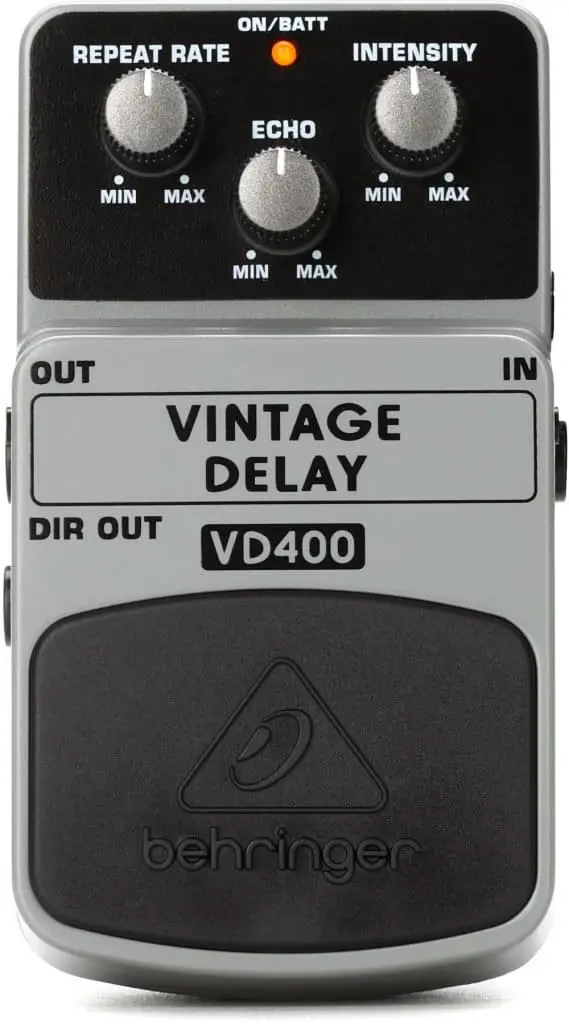
Musicians aren’t known to be the most financially savvy group in the world. I’m going to count myself, especially in my early 20s when I was buying a ton of gear, among that group.
But that doesn’t mean there aren’t solutions.
I don’t own a ton of gear from Behringer. They just never really cross my radar as a company that would be able to nail an analog delay. But you know what? They’ve kind of found a niche for themselves, and here’s a spot where they actually did nail an analog delay.
If you’re a player who has never experimented with a delay pedal and don’t really understand the mechanics of delay time, or what the difference is between a digital delay waveform and that of an analog delay, then this is a good choice to get your feet wet.
Behringer Stays True to Their Mission
Is this pedal going to have the capabilities and delay settings of a multi-mode digital delay setup? Of course not. But it’s also insanely cheap. Under $30. It sounds great and gets the job done without overwhelming a player new to the types of delays that are out there and how analog delays work in general. It does have a true bypass and max delay time of a paltry 300ms, but that’s plenty without giving a new player too much time to get lost.
A delay time of 300ms is enough to do some rockabilly, and add some depth to chord-based riffs without the whole thing getting muddied. Sometimes too much choice can be paralyzing, and that’s what a big fancy digital delay pedal with its 10-second delay time options and multi-mode effects loops can do to a new player.
Beringer’s niche is to make affordable, functional, basic effect stomp boxes, and they’ve done it again with the VD400. Vintage, insanely cheap, and straightforward. As well as fun to play.
• • •
Best Delay Pedals Mini Buyer’s Guide

Not everyone has the same playing situation. Different styles. Different strokes for different folks. It’s important to consider the different available options when picking your digital delay pedal. Do you prefer sharper digital delays or the classic tube analog delay?
These are some of the most common options available in almost every contender for best delay pedals.
Remember, best doesn’t mean perfect, so you’ll need to make a list of what you need in your personal effects loop.
What We Mean by The Best Delay Pedals
An ounce of prevention saves a pound of cure. You may be coming to the table with preconceived notions of what a delay pedal is, or trying to emulate a certain guitarist’s sound.
That’s well and good, but the best delay pedals are an extension to your rig that is almost an instrument unto itself and should be thought of as such. You don’t need to pigeonhole yourself into a style before you even plug in.
U2’s Edge didn’t invent delay pedals, but he revolutionized what a delay setup means to songwriters with his work on Joshua Tree.
His songwriting philosophy is minimalist in nature. His guitar playing style is spartan and deliberately leaves a lot of room in the songs. Then he uses his delay pedals to fill out the song.
The sound is at the same time ephemeral and anthemic. Even if U2 isn’t your jam, you can find inspiration as to what is possible in your own music using the best delay pedals.
So what do you need to think about to get the most out of the best delay pedals in your arsenal?
Analog Delay Pedals Vs. Digital Delay Pedals?
There are only really two types of delay pedals. Analog and digital.
And the preference of delay types is entirely subjective and based on what style of music you’re fond of playing.
Analog sends your guitar’s signal through a series of capacitors that degrade the signal to produce the output.

It’s akin to making a photocopy of a photocopy. Each generation has fidelity loss that is physically created by the process of recreating.
This means that there are only so many times the signal can be processed before you’re left with unintelligible static. Thus analog delay has a relatively short signal delay lifespan. That translates to a shorter delay time.
This means that there’s only so many times the signal can be processed before you’re left with unintelligible static. That means an analog delay has a relatively short signal delay lifespan.
That’s either the benefit or the detriment of analog delays. It’s all in the eye of the beholder.
Using digital delay pedals, on the other hand, is like making a copy of a CD. There’s no physical loss in fidelity.
That means the signal can be processed an unlimited amount of times. There’s no natural change to the signal, so the effect can be as clean or dirty as you want.
The effect can also last indefinitely, though most pedals will impose a limit for practical purposes. Nobody needs the same note looped for ten minutes straight. Though, in theory, there is no max delay time.
Those are the two types of delays in short.
Smart App Connectivity

This is a feature I could never have dreamed of when I first started playing guitar, but now is widespread. We were astounded by midi connectivity.
While using digital emulation via app may run afoul of analog purists, in practice it opens up the history books for inspiration.
Tempo settings
Delay effects are measured in how many milliseconds the loop takes to complete. How that time is set can be set manually with a dial or static setting, or can be set with “tap tempo.”
Tap tempo simply means you’ll tap the pedals button to set the tempo of the effect manually. It’s set by “feel.” To use the tap tempo feature effectively, you need to summon your inner metronome.
Multi Mode Effects

When you’re searching for the right delay you might find yourself looking at multi mode effect pedals. Pedals that have every kind of effect under the sun built in.
If you’re just starting out, a multi-effect pedal can be helpful for acquainting yourself with what a dedicated pedal can do. Their usefulness tends to end there. Multi-effects pedals are usually complicated to use and lack the lush tonal qualities even the lowest-end dedicated pedals produce.
If you have the time and patience to learn the ins and outs of tweaking your sound, they might be a good option. However, if you’re just starting out, a dedicated digital delay might be the more appropriate option.
Loopers
A looping effect allows you to capture a bit of music and play it back on a continuous loop. This can be helpful not only when you’re playing, but also when you’re practicing or writing by yourself.
For instance, you can play a rhythm guitar, loop the piece and work out a lead over the top of the loop.
Delay Pedal Form Factor

You also will want to consider the physical form factor of the pedal you’re looking at and how that will slot into your gear ecosystem.
I’m not going to lie. I’ve actually lost a small distortion pedal at a gig. Just lost it. Misplaced it while tearing down and I don’t think it was stolen or walked off. I’m just prone to losing small things, so I tend to opt for a beefier version of a pedal if multiple form factors are on offer.
Aesthetics are something that’s often thought of last. But the form factor, and the functional qualities, influence whether you’ll want to play the thing.
Don’t believe me? Like we pointed out in our must-have guitar pedals article, even uber shredders like Paul Gilbert believe a beautiful pedal board contributes to the overall musical creative process:
That’s scratching the surface on what to look out for when thinking about the best delay pedal for your particular style of music.
How you express yourself on your guitar is up to you. One beautiful aspect of playing the guitar is that, at a base level, you’ve got six strings and 12 notes, but the possibilities are endless.
A really solid delay pedal is part of that aural equation.
Conclusion
While there’s no universally perfect delay pedal for every conceivable guitar player, this list comprises the best delay pedals on the market today.

We’ve run through a slew of pedals and I’ve decided on the TC Electronic Flashback 2 as my favorite option among the best delay pedals. If you don’t already own a delay pedal, it checks off the most boxes.
It’s not the best at any one thing, but it’s versatile, well-built, and has an app interface that expands its capabilities. Plus, and this can’t be understated, the flashback 2 is inexpensive.
That makes it the best all around for most guitar players and, especially so, for new players. Every other pedal on the list will expand your sonic capabilities but you won’t go sideways picking up a flashback 2.

